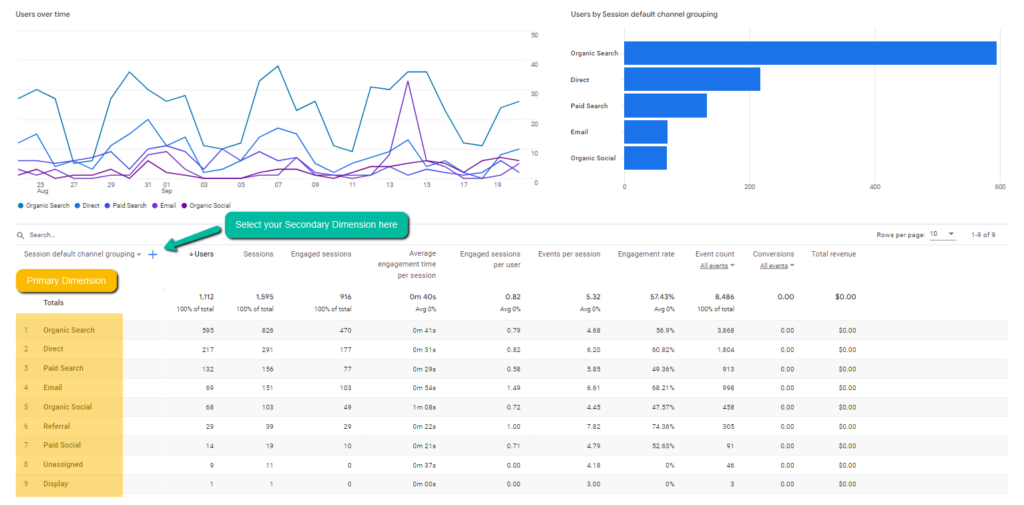Open Advanced Insights with Google Analytics Secondary Dimension Devices
Open Advanced Insights with Google Analytics Secondary Dimension Devices
Blog Article
Opening the Power of Secondary Dimension Analytics for Boosted Information Insights and Decision-Making
In the realm of data analytics, key dimensions commonly take the limelight, but the true depth of understandings exists within the realm of second dimensions. By taking advantage of the power of secondary measurement analytics, companies can reveal covert patterns, reveal relationships, and essence more meaningful verdicts from their information.
Relevance of Second Measurements
Discovering the significance of secondary measurements in analytics reveals the covert layers of data insights important for notified decision-making in various domains. Secondary dimensions give a much deeper understanding of main information by supplying added context and perspectives. By integrating additional measurements into analytics, companies can extract a lot more comprehensive and nuanced insights from their datasets.
One key value of second dimensions is their capability to segment and categorize primary data, allowing for a more in-depth analysis of details parts within a dataset. When looking at the information as a whole, this segmentation allows organizations to recognize patterns, trends, and outliers that could not be apparent. Secondary dimensions assist in revealing connections and dependences between different variables, leading to even more exact forecasting and anticipating modeling - secondary dimension.
In addition, second measurements play a critical role in enhancing data visualization and coverage. By adding additional measurements to visualizations, such as charts or graphes, experts can produce much more insightful and informative representations of data, promoting far better interaction of searchings for to stakeholders. Overall, the assimilation of additional measurements in analytics contributes in opening the full capacity of data and driving evidence-based decision-making.
Trick Advantages of Utilizing Additional Measurements
Using second dimensions in analytics uses organizations a strategic benefit by augmenting the depth and granularity of information understandings. By exploring data using secondary measurements such as time, area, device kind, or individual demographics, organizations can discover patterns, patterns, and correlations that may or else remain covert.
Additionally, the usage of additional dimensions enhances the context in which primary information is interpreted. By leveraging additional dimensions in analytics, organizations can harness the full capacity of their information to drive much better decision-making and attain their service purposes.
Advanced Data Analysis Strategies
A deep dive right into advanced data analysis techniques discloses innovative methods for drawing out important understandings from intricate datasets. One such strategy is equipment discovering, where formulas are employed to recognize patterns within data, forecast outcomes, and make data-driven choices. This approach allows for the automation of analytical design building, allowing the processing of large volumes of information at a much faster rate than traditional techniques.
One more sophisticated technique is anticipating analytics, which uses statistical formulas and artificial intelligence strategies to anticipate future end results based on historical information. By analyzing patterns and patterns, businesses can anticipate customer actions, market patterns, and potential threats, encouraging them to make aggressive decisions.
Additionally, message mining and view evaluation are valuable techniques for removing insights from disorganized information sources such as social media sites remarks, client testimonials, and study responses. By examining text data, organizations can comprehend client viewpoints, recognize emerging trends, and improve their services or products based on feedback.
Enhancing Decision-Making Via Additional Measurements

Enhancing decision-making through additional measurements allows businesses to make even more informed and targeted tactical options. By segmenting customer information based on secondary dimensions like purchasing background or interaction levels, companies can customize their marketing methods to certain audience sectors, leading to boosted conversion prices and customer complete satisfaction. Secondary dimensions can help determine connections and relationships in between different variables, enabling companies to make data-driven decisions that drive development and profitability.
Applying Secondary Dimension Analytics
When including second dimensions in analytics, companies can open deeper insights that drive strategic decision-making and improve total performance. Applying additional measurement analytics requires an organized method to make certain effective utilization of this you could check here powerful device. The initial step is to identify the key metrics and dimensions that straighten with the company's calculated goals. This involves recognizing the certain questions the company seeks to respond to and the information factors needed to resolve them.

Additionally, organizations need to utilize progressed analytics tools and innovations to simplify the process of incorporating second measurements. These tools can automate information handling, evaluation, and visualization, permitting companies to focus on translating insights instead of hand-operated information control.
Conclusion
In final thought, secondary measurement analytics play a crucial function in improving data understandings and decision-making processes. By making use of advanced information evaluation methods and executing secondary dimensions properly, companies can unlock the power of their data to drive critical business choices. The essential advantages of utilizing second measurements can not be overemphasized, as they offer a much deeper understanding of data trends and connections. It is vital for companies to leverage additional measurement analytics to remain affordable in today's data-driven landscape.
In the realm of information analytics, primary dimensions commonly take the spotlight, however the real depth of insights exists within the realm of additional measurements.Making use Check This Out of additional dimensions in analytics offers organizations a calculated advantage by boosting the deepness and granularity of information insights. By leveraging second dimensions in analytics, organizations can harness the complete possibility of their information to drive far better decision-making and attain their business goals.
Carrying out information recognition processes and routine audits can assist keep data top quality and dependability.
By utilizing advanced data evaluation strategies and executing additional dimensions efficiently, organizations can open the power of their data to drive calculated organization choices.
Report this page